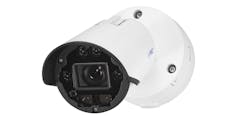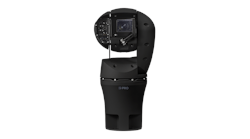IP In Security
IP technologies are finding an increasing number of applications in all areas of security including video, access control, intercoms and power distribution.
What comes to mind immediately are CAT-5 cabling and RJ-45 connectors, essential network tools which are always used in network topology and for other non-IP applications.
CAT-5 cable is a special four pair construction of solid conductors with very specific electrical characteristics with respect to impedance, capacitance, twists, and resistance so that the performance of connected hardware may be accurately predicted. But due to the economy of scale, that is, the fact that CAT-5 is a mass-produced commodity it is consequently readily available and reasonably priced.
RJ-45 connectors and receptacles are too.
Information technology (IT) is refers to the design, implementation, support and management of computer-based information systems.
Implementation refers to converting, storing, protecting, processing, transmitting, and securely retrieving information.
Information can refer to speech video, data, and in some instances, power.
Information technology is starting to spread farther than the conventional personal computer and network technology, and more into integrations of other technologies such as those used in security.
A network is a collection of devices connected by communications channels that facilitates communications among users and allows users to share resources with other users. Networks may be classified according to a wide variety of characteristics.
The Internet Protocol (IP) is a protocol used for communicating data across a packet-switched internetwork using the Internet Protocol Suite, also referred to as TCP/IP.
IP is the primary protocol in the Internet Layer of the Internet Protocol Suite and has the task of delivering distinguished protocol datagrams (packets) from the source host to the destination host solely based on their addresses. The Internet Protocol defines addressing methods and structures for datagram encapsulation.
The first major version of addressing structure, now referred to as Internet Protocol Version 4 (IPv4) is still the dominant protocol of the Internet, although the successor, Internet Protocol Version 6 (IPv6) is being deployed actively worldwide.
But in security we may also use the terms IP and networks in a casual way to describe other products and technologies which incorporate individual characteristics of IP without literally being IP or network appliances.
Video is an excellent example. It is often referred to as CCTV (Closed Circuit TeleVision), but where IP and networks have been introduced, the circuit is anything but closed, since as is well known, the Internet is almost limitless in scale: it can include virtually any number of nodes and it can accommodate virtually any volume of data.
An IP camera is a sophisticated device which is actually a server that provides video using a computer network. It communicates exclusively with other computers and network appliances.
But analog cameras are also in use extensively, and their outputs can connect directly to analog hardware such as DVRs, or bridged over to networks.
DVRs are transitioning to hybrids, which can accommodate both analog cameras as well as IP cameras.
Analog cameras use coaxial cable and BNC connectors, unless the analog signal is converted to UTP (unshielded twisted pair) cable and hardware, in which case CAT-5 cables and RJ-45 terminations come into play.
All DVRs convert video into digital data and store it on hard drives and other computer based media. Virtually all DVRs used these days employ IP and IT technologies to enable network based camera viewing and archiving.
DVRs are giving way to video servers which are PCs equipped with capture cards and hard disk drives designed specifically for the demanding duty of running constantly and storing huge volumes of data.
Intercoms are also making the transition to digital networked signal processing. We review one which is a pure IP device while the other is a hybrid combining a variety of technologies to provide open frame functionality.
AIPHONE AX INTEGRATED SYSTEM
The AX Series offers integration into existing security systems including CCTV, electronic access control and CO Lines. The system supports up to eight master stations and 120 sub-stations all wired on CAT-5. The AX Series is PC programmable so system communication and functionality is set-up in a snap.
Other features include: Call Transfer, Priority call-in, private communication, selective contacts for door strikes or camera call up, outside telephone line forwarding and scan monitoring. HID® ProxPoint® Plus embedded audio-video door stations are also available to create a complete all-in-one solution.
AX is comprised of door stations, master stations, Central Exchange Units (CEU), power supplies and other external connections which may be configured to provide a network-based open architecture solution.
The heart of the system is the exchange unit which is a network-type appliance which can be wall, desk or rack mounted.
AIPHONE AX-084C EXCHANGE
Audio/Video and/or Audio-only Master or Door Stations connect directly to this unit via homerun CAT-5e wiring and RJ45 jacks.
The AX-084C supports up to four master stations and up to eight door/sub stations. The AX-084C can be expanded in increments of 32 for up to 104 door/dub stations with the use of AX-320C add-on CEUs.
The CEU handles the calling and communication signals for the system, as well as providing selective door release outputs, video outputs, DVR trigger outputs, and CO line transfer output. System set-up and a variety of functions are programmed in the CEU with the use of the supplied software.
Power is applied directly to the CEU via two PS-2420UL power supplies. The serial connection is for uploading the system programming, for raw RS232 data output, or for system monitoring via the supplied program.
The unit can be surface mounted to a wall, desk mounted, or mounted in a standard 19” EIA rack using the supplied mounting brackets.
AX System features include:
CAT-5e wiring from each station
Up to 8 masters and 120 remote stations
Two talk channels
PTT or VOX operation
Master-to-master selective calling
All Call between master stations only
Masters available with 3.5" color TFT LCD
Composite video output from CEU and master station
Standard or priority call levels from door stations
Communication privacy
Electronic access control integration*
CCTV system integration*
Selective remote control (e.g. door release)
PC interface for programming and event logging
Scan monitoring of selected remote stations
Rack or wall mountable CEU
Calls queued in order of priority and call-in time
Compatible with IE Series door stations
Optional features: headset, footswitch,
call transfer to telephone and PC remote control (Interface requires custom program not supplied by Aiphone)
AIPHONE IPW-1A
The IPW-1A offers voice-quality Intercom function over standard IP based networks. Designed specifically to integrate seamlessly into a new or existing LAN / WAN infrastructure, the IPW-1A system is capable of supporting hundreds of stations. Providing intercom/paging solutions to a large variety of applications including commercial, industrial, residential, general security, office, and institutional.
Key features include:
Cost-effective multi-master (PC-based) based design
Compatible with IE Series sub stations and AX-DM
Scalable to hundreds of stations / locations
Works with standard wired and wireless network infrastructure. (LAN/WAN)
Digital audio recording and playback capability via included software.
Relay output for remote release (N/O or N/C)
Up to 387'/(2 CONDUCTOR 22AWG); 980'/(2 CONDUCTOR 18AWG) between door station and IPW-1A
One year warranty effective when device is deployed
Hardware Specifications:
Input Voltage: Use Aiphone PT-1211C (included); 15-24V AC/DC
Network Interface: 10/100 Base-T Ethernet (Auto detection) RJ-45
IP Assignment: Static or Dynamic
Hardware Protocols: TCP/IP, UDP, DHCP, SNMP, AutoIP, SonicIP, Ipzator
(Contact Aiphone for additional Transport Bandwidth:
˜128Kbps per active session (normal mode)
˜64Kbps per active session (low bandwidth mode)
Audio Encoding: PCM (raw), G.7II ( Law)
Audio Sampling: 16bit at 8kHz (normal mode) 8bit at 8kHz (low bandwidth mode)
Output Level: Determined by sub station
Dimensions: 1-1/2" H x 4-1/4" W x 4-15/16"D
CommuniCenter SoftwareSystem Requirements:
Operating System: Microsoft Windows XP (SP2), Windows Vista
Processor: 1 GHz or faster
Memory: 256MB of RAM
Hard drive: 50MB of available disk space
Sound Card: Windows supported sound card (w/ speaker & microphone)
HID EDGE
EDGE is the next evolution in access control hardware solutions. EDGE provides fully distributed intelligence and decision making right to the door, leveraging the IT infrastructure to the maximum extent possible. EDGE power comes through a single CAT-5 run to the door, and EDGE IP Access Solutions run everything at the door from reader to strike, status to REX. And since each EDGE IP Access Solution can utilize PoE (Power over Ethernet) driven right through the CAT-5, separate power supplies and multi-door controllers are no longer required. EDGE configurations are exactingly constructed for Host environments as well as single door applications with a wide range of unique benefits. The simplicity of EDGE is available for iCLASS readers or the option of a wide array of readers when choosing an EDGEPlus solution.
ALTRONIX HUBWAY
UTP is a proven and widely accepted means of transmitting video where excessive distances, specific site characteristics, and large numbers of cameras make traditional coax less appropriate.
HubWayLD162CD Active UTP Transceiver Hub with Integral Camera Power with 16 HubWayAv Video Balun/Combiners provides a total solution for video systems where coax is not feasible or cost effective. Altronix has several models in its Hubway line.
Altronix HubWayLD162CD Active UTP Transceiver Hub w/Integral Camera Power transmits UTP video, RS422/RS485 data and power over a single CAT-5 or higher structured cable.
The Hubway also provides a high degree of surge protection to the cameras and other head-end equipment.
CAT-5 cable is less expensive than traditional Coax/Siamese, weighs less; takes up less space, and is easier to handle and install. Also CAT-5 may be spliced without signal degradation.
The unit provides 16 camera channels in a space saving 1U EIA 19” rack mount chassis.
Video transmission range is up to 3000 ft. max. per channel depending on the power requirements of the cameras used.
HubWayLD162CD Active UTP Transceiver Hub Units are compatible with AC fixed or PTZ cameras when utilizing Altronix HubWayAv Video Balun/Combiners.
The HubWayLD162CD Active UTP Transceiver Hub unit features individually selectable 24VAC or 28VAC PTC protected outputs with surge suppression allowing individual camera runs to be better tuned to cable length and camera power requirements.
An optional HubSat4D Passive UTP Transceiver Hub with Integral Camera Power can be used as an accessory module to transmit video from up to 4 cameras over a single CAT-5 or higher structured cable back to the HubWayLD16CD. The HubSat4D provides power to these cameras locally to eliminate voltage drop associated with long cable runs.
Features/Specifications:
Individual selectable 24VAC or 28VAC power outputs with OFF position.
Unit provides up to 1 amp max. per channel not to exceed a total of 10 amp (300VA) maximum current.
PTC protected outputs.
PTCs are rated @ 1 amp per channel.
Class 2 Rated power limited outputs.
Surge suppression.
Picture and Grain control.
Primary fuse (internal) is rated at 5 amp/250V.
Input 115VAC 60Hz, 3 amp.
Data:- RS422/RS485 data input
Video: 16 channels of video over twisted pair up to 3000 ft., 16 75 ohm video outputs.
Sixteen (16) individual power LED indicators.
Illuminated master power disconnect circuit breaker with manual reset.
IEC320 - 3-wire grounded line cord (detachable).
Rack, wall or shelf mount.
Includes 16 UL Listed Accessory AC (HubWayAv) Video Balun/Combiners.
Rack Chassis
Modular 1U standard EIA 19” rack mount chassis.
1.625”H x 19.125”W x 8.5”D.
Accessories:
BNC24J 24” Male to Male Coax Jumper; HubWayAv 24/28VAC Video Balun/Data/Video Combiner; HubWayDv 12VDC Video Balun/Data/Video Combiner; HubWayDvi 12VDC isolated Video Balun/Data/Video Combiner.
Tim O'Leary
Tim O'Leary is a security consultant, trainer and technician who has also been writing articles on all areas of locksmithing & physical security for many years.





